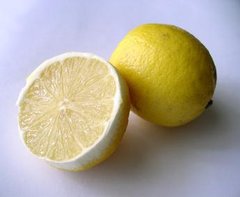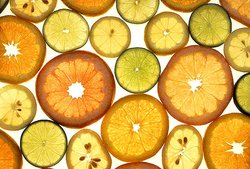Citrus
|
|
| Citrus | ||||||||||||||
|---|---|---|---|---|---|---|---|---|---|---|---|---|---|---|
 Lemons | ||||||||||||||
| Scientific classification | ||||||||||||||
| ||||||||||||||
| Species & major hybrids | ||||||||||||||
|
Species |
Citrus is a common term and genus of flowering plant in the family Rutaceae, originating in tropical and subtropical southeast Asia. The genus contains three species, and numerous natural and cultivated origin hybrids, including commercially important fruit such as the orange, lemon, grapefruit, lime, and tangerine. The taxonomy of the genus is complex, but recent genetic evidence (see e.g. external link cited below) supports the presence of only three species, C. maxima, C. medica and C. reticulata, with all the other taxa previously accepted as species being of hybrid origin between these three. They are large evergreen shrubs or small trees, reaching 5-15 m tall.
Citrus fruits are notable for their fragrance, and most are juice-laden. They contain a high proportion of citric acid giving them their characteristic astringent odour and flavour. They are also good sources of vitamin C. In botanical terms, "The fruit of all Citrus trees, in which the true fruit is the peel, [is] made up of an outer layer, brightly colored and rich in glands, a spongey whitish mesocarp, and a membraneous endocarp surrounding the segments. The succulent parts we eat is only a secondary tissue developed as a filler" - Paola Lanzara and Mariella Pizzetti Simon & Schuster's Guide to Trees, pp. 44.
As citrus trees hybridize very readily (e.g., seeds grown from limes can produce fruit similar to grapefruit), all commercial citrus cultivation uses trees produced by grafting the desired fruiting cultivars onto rootstocks selected for disease resistance and hardiness.
Culture
Citrus trees are not generally frost hardy. A few hardy hybrids can withstand temperatures somewhat below freezing, but do not produce quality fruit. In the U.S., Florida, Texas, and California are major commercial citrus-producing regions, while smaller plantings are present in other Sun Belt states.
The trees do best in a consistently sunny, humid environment with fertile soil and adequate rainfall or irrigation. Though broadleaves, they are evergreen and do not drop leaves except when stressed. The trees blossom in the spring, and fruit is set shortly afterward. Fruit begins to ripen in fall or early winter months, depending on variety, and develops increasing sweetness afterward.
Citrus trees grown in tubs and wintered under cover were a feature of Renaissance gardens, once glass-making technology enabled sufficient expances of clear glass to be produced. The Orangerie at the Palace of the Louvre, 1617, inspired imitations that were not eclipsed until the development of the modern greenhouse in the 1840s. An orangery was a feature of royal and aristocratic residences through the 17th and 18th centuries. In the United States the earliest surviving orangery is at the Tayloe House, Mount Airy, Virginia.
Some modern hobbyists still grow dwarf citrus in containers or greenhouses in areas where it is too cold to grow it outdoors. Consistent climate, sufficient sunlight, and proper watering are crucial if the trees are to thrive and produce fruit. For cooler areas, lime and lemon tend to produce the best fruit, due to their lower sugar levels.
List of citrus fruits
- Amanatsu
- Bergamot orange
- Bitter orange (Seville Orange)
- Calamondin (Calamansi)
- Citron
- Clementine
- Golden Lime - hybrid between the genus Citrus and the genus Fortunella
- Dancy
- Grapefruit
- Ichang Lemon
- Kaffir lime
- Key lime
- Kumquat - in the related genus Fortunella, not Citrus; forms hybrids with Citrus
- Lemon
- Lime
- Limequat
- Mandarin Lime
- Mandarin Orange
- Meyer Lemon
- Mikan
- Minneola
- Orange
- Orangelo (Chironja)
- Orangequat
- Persian lime (Tahiti lime)
- Pomelo
- Pummelo (Shaddock)
- Rangpur (Lemanderin)
- Rough Lemon
- Satsuma
- Shekwasha (Taiwan Tangerine)
- Sweetie
- Tachibana Orange
- Tangelo
- Tangerine
- Tangor
- Ugli
- Yuzu
External links
Citrus taxonomy (abstract) (http://www.corse.inra.fr/pub95/p95sr10.htm)de:Zitrusfrucht es:Cítrico fr:Citrus it:Citrus nl:citrusvrucht ja:カンキツ pl:Cytrus fi:Sitruspuut

